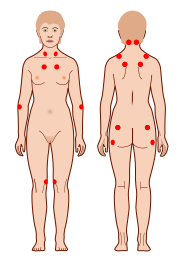 What Is Fibromyalgia?
What Is Fibromyalgia?
Fibromyalgia is one of the conditions we get asked about most at CoreWalking.
To be honest I think that is because the idea of learning how to walk for any reason, whether it is for chronic pain or improved athletic performance, still strikes many people as ludicrous.
For whatever reason, most people think, “I walk therefore I walk correctly” which isn’t the truth.
So, people with fibromyalgia after exhausting every resource at their disposal—often with no positive result—find me while desperately cruising the internet in search of information and solutions.
Fibromyalgia falls into one of my least favorite categories of pain and injury; the category of “cause unknown”, that can’t be cured. Numerous injuries and ailments fall under this umbrella and they always leave me confused and more than a little frustrated.
And before I get into whether CoreWalking can actually help with fibromyalgia (it can) I want to offer a primer on exactly what it is.
I often describe my work as an attempt to make what’s complex simple, so I will now do my best to apply that effort to this consternating condition.
Fibromyalgia is the diagnosis applied when people meet certain factors.
You need to be in chronic pain— which is considered to be pain lasting more than three months—with pain in at least 5 areas that are tender to the touch, and pain which usually occurs at 6 or higher on a scale of 1 to 10. There is also a lower threshold for pain.
areas that are tender to the touch, and pain which usually occurs at 6 or higher on a scale of 1 to 10. There is also a lower threshold for pain.
People with fibromyalgia have trouble dealing with pain because of confusion in the nervous system which I will describe below.
This confusion about pain leads to a greater sensitivity in many areas, including mood, sleep, and digestion, and often creates a negative feedback loop that heightens all of its effects
The way the body works is when we experience pain the nervous system goes to work to process the event and provide a solution.
Pain is an important part of the survival of the human organism. But pain isn’t a thing unto itself, it is a warning sign that something has gone wrong that needs to be dealt with. The way it should work is that when we feel pain, for whatever reason, the experience of that pain leads to a healing of the cause of the pain.
In the case of fibromyalgia, normal methods of feeling and processing pain fail to work effectively.
The symptoms of fibromyalgia run a wide gamut from muscle pain, fatigue, headaches, muscle tension, urinary issues, nausea, joint stiffness, anxiety, depression, sleep issues, and believe it or not I could list several others but you get the drift.
Before diving into how fibromyalgia occurs I want to define some aspects of the nervous system that factor into what is happening when this condition is present. And I have to admit this stuff is not easily made simple but I will give it my best shot.
- A neuron is an essential building block of the nervous system. designed to transmit information throughout the body. There are three types of neurons.
- Sensory neurons carry information from the body to the brain.
- Motor neurons transmit information from the brain to the muscles and.
- Interneurons allow different neurons to communicate with each other.
- Nociceptors are sensory neurons found mostly in the skin, joints and walls of our organs and they respond to trouble by alerting the brain to possible threats.
- Neurotransmitters send signals between nerve cells. Here are two important neurotransmitters involved with fibromyalgia:
- Serotonin is a chemical produced by nerves found mostly in the digestive system. It is a mood stabilizer thought to help with essential functions like sleeping eating and digesting. can be described as a pain inhibitor on one level and a happiness emitter on another.
- Norepinephrine is released from sympathetic nerve fibers (read more about the sympathetic nervous system and our fight or flight response here) when something stressful happens and it acts to help the body respond by increasing our heart rate and blood flow to muscles as well as releasing glucose or sugar into the blood—all of which essentially wakes us up and gets us ready for action and reaction.
- Substance P is the main neurotransmitter and promoter of pain. It is released when something happens to us and it creates the perception of pain which encourages a response to deal with that pain.
- Nerve growth factor is a neuropeptide and neuropeptides are used by neurons to communicate with each other. Nerve growth factor are created en masse when we are in pain. The more pain we are in the more nerve growth factor that are created and employed. They also increase the release of more substance P as well as increasing sensitivity to pain
And now, what is Fibromyalgia?
Let’s say we twist our ankle. When the injury occurs a nociceptor translates that action into a signal to the spinal cord and central nervous system that releases substance P if needed (depending on the intensity of the ankle injury).
While substance P is doing its thing, the pain inhibitors serotonin and norepinephrine are employed to counter substance P and decrease the pain.
At the same time, if we go back to the ankle, nerve growth factor is released at the site, which in turn stimulate the growth of more nociceptors— increasing sensitivity to pain and creating more substance P.
This is all well and good if all of these factors work as I describe above but in the case of fibromyalgia there is an issue with how the central nervous system receives and processes pain signals.
And here’s the rub: people with fibromyalgia seem to have low levels of serotonin and elevated levels of substance P and nerve growth factor, upending the nature of things. The pain inhibitors are decreased while the pain stimulators are increased.
This leads to a hypersensitivity to not only pain, but many of life’s basic functions such as sleep, digestion and mood, which takes us back to the negative feedback look I mentioned at the beginning.
It is not a big leap to think that a heightened sensitivity to pain can lead to depression and anxiety.
At the same time low levels of serotonin, which is produced mainly by nerves in the digestive system, can mess with our digestion and the combination of all of these factors can create problems with our sleep patterns and cycles.
It is a truly a vicious circle that can take over our lives and leave us without hope. I know this personally from all of the people with whom I have worked who are saddled with fibromyalgia.
So, after all of that, let me get to how I think my CoreWalking Program can help people who are suffering with Fibromyalgia.
First and foremost, fibromyalgia is a nerve condition and the way I teach people to walk and stand is meant to align the bones to allow for the freest flow of nervous energy through the body.
When it comes to walking and posture, our bones hold us up, our muscles move us and the nerves tell the muscles to move the bones.
We want to align the bones in such a way that we give the nerves the best possible chance to flow and serve the body.
Most people walk and stand in ways that misalign themselves by leaning backwards and compressing the back of the body from head to toe. That compression messes with the effective flow of nervous energy.

When we learn to walk and stand correctly our nerves are better aligned to make their way through the body which gives us more and better energy. Even the most sedentary person is taking 3000 steps a day. Imagine if those steps were well executed and you start to get an idea of the benefits of better walking technique.
But since my walking program is geared towards chronic as well as acute pain, I learned early on that while moving well is key to healing, there are many other factors involved as well.
Starting with sleep. Sleep is the first thing I talk about when I work with anyone with chronic pain. Lack of sleep creates a vicious pain cycle of its own. We need sleep to heal but pain keeps us from sleeping.
My initial approach to almost everyone I work with who suffers from chronic pain is to work on getting even an extra half hour of sleep a night because you have to start somewhere.
To that end the first exercise I get everyone to do in the walking program is called constructive rest position, a psoas muscle release exercise that allows the body to profoundly relax and let go of tension.
Over the years I have found few things more effective.
Depending on nature and extent of one’s suffering it is not unheard of to do constructive rest for 30 minutes before sleep and 30 minutes immediately upon getting out of bed.
And then if you combine that with walking and standing well over the course of the day you are likely to see improvement where before you thought that all was lost.
And the ultimate and sometimes painful truth is—not everyone gets out of pain.
This was another realization I had early on. While there are plenty of people with general pain and injury that use my walking program get out of pain completely, there are other people with structural and congenital issues that prevent complete and total healing.
For them, I offer a support system that over time has proven to be incredibly valuable. If you have spent years with a pain level of 7 on a scale of 1 to 10 and you can knock that down to a 2 or 3, how great would that be?
At first, I wanted to believe that I could help anyone find their way to a pain free life and it was humbling to realize that it wasn’t always the case.
But at the same time, I have seen time and time again, the value of support and minimizing pain that isn’t always going to go away forever.
It isn’t that I think the assorted medications that are offered to people who struggle with fibromyalgia can’t or don’t help, but I think taking a holistic approach to healing by making better use of the whole body while taking those medications can only help.
